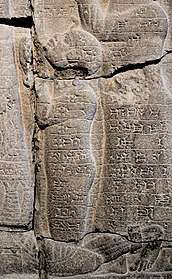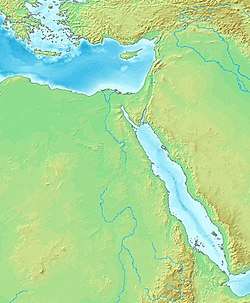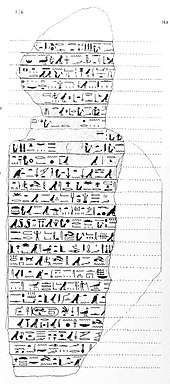Taharqa
Taharqa, also spelled Taharka or Taharqo (Egyptian: 𓇿𓉔𓃭𓈎 tꜣ-h-rw-k, Neo-Assyrian: ![]()
| Taharqa | |||||||||||||||||||||||||||||||||||||||||||||||||||||||||||||||||||||||||||||||||||||||||||||||||
|---|---|---|---|---|---|---|---|---|---|---|---|---|---|---|---|---|---|---|---|---|---|---|---|---|---|---|---|---|---|---|---|---|---|---|---|---|---|---|---|---|---|---|---|---|---|---|---|---|---|---|---|---|---|---|---|---|---|---|---|---|---|---|---|---|---|---|---|---|---|---|---|---|---|---|---|---|---|---|---|---|---|---|---|---|---|---|---|---|---|---|---|---|---|---|---|---|---|
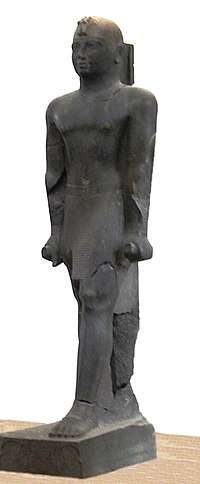 Statue of Taharqa. His name appears on the center of his belt: 𓇿𓉔𓃭𓈎 (tꜣ-h-rw-k, "Taharqa"). The statue is 2.7 meters tall. Taharqa has a striding pose, the arms held tight, and holds the mekes staff. He wears a pleated kilt called shendjyt and on the head the double uraeus signifying the double rule over Nubia and Egypt. Kerma Museum.[2] | |||||||||||||||||||||||||||||||||||||||||||||||||||||||||||||||||||||||||||||||||||||||||||||||||
| Pharaoh | |||||||||||||||||||||||||||||||||||||||||||||||||||||||||||||||||||||||||||||||||||||||||||||||||
| Reign | 690–664 BC (25th dynasty) | ||||||||||||||||||||||||||||||||||||||||||||||||||||||||||||||||||||||||||||||||||||||||||||||||
| Predecessor | Shabaka | ||||||||||||||||||||||||||||||||||||||||||||||||||||||||||||||||||||||||||||||||||||||||||||||||
| Successor | Tantamani | ||||||||||||||||||||||||||||||||||||||||||||||||||||||||||||||||||||||||||||||||||||||||||||||||
| |||||||||||||||||||||||||||||||||||||||||||||||||||||||||||||||||||||||||||||||||||||||||||||||||
| Consort | Great Queen Takahatenamun, Atakhebasken, Naparaye, Tabekenamun[4] | ||||||||||||||||||||||||||||||||||||||||||||||||||||||||||||||||||||||||||||||||||||||||||||||||
| Children | Amenirdis II, Ushankhuru, Nesishutefnut | ||||||||||||||||||||||||||||||||||||||||||||||||||||||||||||||||||||||||||||||||||||||||||||||||
| Father | Piye | ||||||||||||||||||||||||||||||||||||||||||||||||||||||||||||||||||||||||||||||||||||||||||||||||
| Mother | Abar | ||||||||||||||||||||||||||||||||||||||||||||||||||||||||||||||||||||||||||||||||||||||||||||||||
| Died | 664 BC | ||||||||||||||||||||||||||||||||||||||||||||||||||||||||||||||||||||||||||||||||||||||||||||||||
| |||||||||||
| t h r ḳ (Taharqo) in hieroglyphs |
|---|
Early life
Taharqa was the son of Piye, the Nubian king of Napata who had first conquered Egypt. Taharqa was also the cousin and successor of Shebitku.[7] The successful campaigns of Piye and Shabaka paved the way for a prosperous reign by Taharqa.
Ruling period
Taharqa's reign can be dated from 690 BC to 664 BC.[8] Evidence for the dates of his reign is derived from the Serapeum stele, catalog number 192. This stela records that an Apis bull born and installed (fourth month of Season of the Emergence, day 9) in year 26 of Taharqa died in Year 20 of Psamtik I (4th month of Shomu, day 20), having lived 21 years. This would give Taharqa a reign of 26 years and a fraction, in 690–664 BC.[9]
Irregular accession to power
Taharqa explicitly states in Kawa Stela V, line 15, that he succeeded his predecessor (generally assumed to be Shebitku but now established to be Shabaka instead) after the latter's death with this statement: "I received the Crown in Memphis after the Falcon flew to heaven."[10] The reference to Shebitku was an attempt by Taharqa to legitimise his accession to power.[11] However, Taharqa never mentions the identity of the royal falcon and completely omits any mention of Shabaka's intervening reign between Shebitku and Taharqa possibly because he ousted Shabaka from power.[12]

In Kawa IV, line 7-13, Taharqa states:
He (Taharqa) sailed northward to Thebes amongst the beautiful young people that His Majesty, the late King Shabataqo/Shebitku, had sent from Nubia. He was there (in Thebes) with him. He appreciated him more than any of his brothers. (There here follows a description of the [poor] state of the temple of Kawa as observed by the prince). The heart of his Majesty was in sadness about it until his Majesty became king, crowned as King of Upper and Lower Egypt (...). It was during the first year of his reign he remembered what he had seen of the temple when he was young.[13]
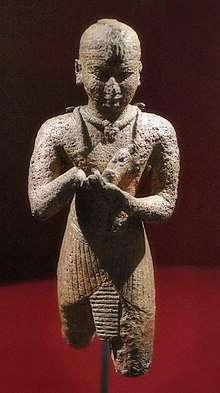
In Kawa V: line 15, Taharqa states “I was brought from Nubia amongst the royal brothers that his Majesty had brought. As I was with him, he liked me more than all his brothers and all his children, so that he distinguished me. I won the heart of the nobles and was loved by all. It was only after the hawk had flown to heaven that I received the crown in Memphis.”[14]
Therefore, Taharqa says that King Shebitku, who was very fond of him, brought him with him to Egypt and during that trip he had the opportunity to see the deplorable state of the temple of Amun at Kawa, an event he remembered after becoming king. But on Kawa V Taharqa says that sometime after his arrival in Egypt under a different king whom this time he chose not to name, there occurred the death of this monarch (Shabaka here) and then his own accession to the throne occurred. Taharqa's evasiveness on the identity of his predecessor suggests that he assumed power in an irregular fashion and chose to legitimise his kingship by conveniently stating the possible fact or propaganda that Shebitku favoured him "more than all his brothers and all his children."[11]
Moreover, in lines 13 – 14 of Kawa stela V, His Majesty (who can be none other but Shebitku), is mentioned twice, and at first sight the falcon or hawk that flew to heaven, mentioned in the very next line 15, seems to be identical with His Majesty referred to directly before (i.e. Shebitku).[15] However, in the critical line 15 which recorded Taharqa's accession to power, a new stage of the narrative begins, separated from the previous one by a period of many years, and the king or hawk/falcon that flew to heaven is conspicuously left unnamed in order to distinguish him from His Majesty, Shebitku. Moreover, the purpose of Kawa V, was to describe several separate events that occurred at distinct stages of Taharqa's life, instead of telling a continuous story about it.[15] Therefore, the Kawa V text began with the 6th year of Taharqa and referred to the High Nile flood of that year before abruptly jumping back to Taharqa's youth at the end of line 13.[15] In the beginning of line 15, Taharqa's coronation is mentioned (with the identity of the hawk/falcon—now known to be Shabaka—left unnamed but if it was Shebitku, Taharqa's favourite king, Taharqa would clearly have identified him) and there is a description given of the extent of the lands and foreign countries under Egypt's control but then (in the middle of line 16) the narrative switches abruptly back again to Taharqa's youth: "My mother was in Ta-Sety …. Now I was far from her as a twenty year old recruit, as I went with His Majesty to the North Land".[15] However, immediately afterwards (around the middle of line 17) the text jumps forward again to the time of Taharqa's accession: "Then she came sailing downstream to see me after a long period of years. She found me after I had appeared on the throne of Horus...".[15] Hence, the Kawa V narrative switches from one event to another, and has little to no chronological coherence or value.
Reign
_%2C_Kerma_Museum%2CSudan_(2).jpg)
Although Taharqa's reign was filled with conflict with the Assyrians, it was also a prosperous renaissance period in Egypt and Kush. When Taharqa was about 20 years old, he participated in a historic battle with the Assyrian emperor Sennacherib at Eltekeh. According to the Hebrew Bible, at Hezekiah's request, Taharqa and the Egyptian/Kushite army managed to stall the Assyrian advance on Jerusalem, with Sennacherib eventually abandoning the siege due to the loss of 185,000 soldiers at the hand of the Lord according to the Biblical account. The might of Taharqa's military forces was established at Eltekeh, leading to a period of peace in Egypt.
During this period of peace and prosperity, the empire flourished. The power of the 25th Dynasty reached a climax under Taharqa. The Nile valley empire was as large as it had been since the New Kingdom. New prosperity[16] revived Egyptian culture.[17] Religion, the arts, and architecture were restored to their glorious Old, Middle, and New Kingdom forms.
In the sixth year of Taharqa's reign, prosperity was also aided by abundant rainfall and a large harvest. Taharqa took full advantage of the lull in fighting and abundant harvest. He restored existing temples, built new ones, and built the largest pyramid in the Napatan region. Particularly impressive were his additions to the Temple at Karnak, new temple at Kawa, and temples at Jebel Barkal.[18][19][20][21][22]
It was during the 25th dynasty that the Nile valley saw the first widespread construction of pyramids (many in modern Sudan) since the Middle Kingdom.[23][24][25]
Assyrian invasion of Egypt
Taharqa enjoyed some minor initial success in his attempts to regain Egyptian influence in the Near East. He aided King Hezekiah from attack by Sennacherib and the Assyrians (2 Kings 19:9; Isaiah 37:9), however disease among the besieging Assyrian army appears to have been the main cause of failure to take Jerusalem rather than any military setback, and Assyrian records indicate Hezekiah was forced to pay tribute. The Assyrian King Sennacherib then defeated Taharqa and drove the Nubians and Egyptians from the region and back over the Sinai into Egypt. It was during his reign that Egypt's enemy Assyria at last invaded Egypt.
Campaigns of Esarhaddon
Esarhaddon led several campaigns against Taharqa, which he recorded on several monuments. His first attack in 677 BC, aimed at pacifying Arab tribes around the Dead Sea, led him as far as the Brook of Egypt.
1st campaign (673 BCE)
Esarhaddon then proceeded to invade Egypt proper in Taharqa's 17th regnal year, in the winter of 673, after Esarhaddon had settled a revolt at Ashkelon. Taharqa defeated the Assyrians on that occasion. This invasion, which only a few Assyrian sources discuss, ended in what some scholars have assumed was possibly one of Assyria's worst defeats.[26] The Egyptians had for years sponsored rebels and dissenters in Assyria and Esarhaddon had hoped to storm Egypt and take this rival out in one fell swoop. Because Esarhaddon had marched his army at great speed, the Assyrians were exhausted once they arrived outside the Egyptian-controlled city of Ashkelon, where they were defeated by Taharqa. Following this defeat, Esarhaddon abandoned his plan to conquer Egypt for the moment and withdrew back to Nineveh.[27]
2nd campaign (671 BCE)
In the early months of 671 BCE, Esarhaddon again marched against Egypt.[28] The army assembled for this second Egytian campaign was considerably larger than the one Esarhaddon had used in 673 and he marched at a much slower speed in order to avoid the problems that had plagued his previous attempt.[27] Esarhaddon's forces were victorious in their first battle with the Egyptians.
The Assyrian army defeated the Egyptians in two additional battles and successfully seized and plundered the Egyptian capital of Memphis.[29] The Assyrian army was also forced to fight some of their vassals in the Levant, such as Baal of Tyre, who had allied with the Egyptians against Esarhaddon.[30]
Although the Pharaoh Taharqa had escaped to the south, Esarhaddon captured the Pharaoh's family, including his son and wife, and most of the royal court, which were sent to Assyria as hostages. Governors loyal to the Assyrian king were placed in charge of the conquered territories. In his Victory stele, erected to commemorate the defeat of Egypt, Esarhaddon is depicted in a majestic pose with a war mace in his hand and royal captives kneeling before him in shakles. One of them is the son of the defeated pharaoh, kneeling in shakles with a rope around his neck.[27] The conquest resulted in the relocation of a large number of Egyptians to the Assyrian heartland.[31] In an excerpt from the text inscribed on his victory stele, Esarhaddon describes the conquest with the following words:
"I slew multitudes of his [e.g. Taharqa's] men and I smote him five times with the point of my javelin, with wounds from which there were no recovery. Memphis, his royal city, in half a day, with mines, tunnels, assaults, I besieged, I captured, I destroyed, I devastated, I burned with fire. His queen, his harem, Ushanahuru, his heir, and the rest of his sons and daughters, his property and his goods, his horses, his cattle, his sheep, in countless numbers, I carried off to Assyria. The root of Kush I tore up out of Egypt and not one therein escaped to submit to me. Over all of Egypt I appointed anew kings, viceroys, governors, commandants, overseers and scribes. Offerings and fixed dues I established for Assur and the great gods for all time; my royal tribute and tax, yearly without ceasing, I imposed upon them.
I had a stele made with my name inscribed thereon and on it I caused it to be written the glory and valor of Assur, my lord, my mighty deeds, how I went to and from the protection of Assur, my lord, and the might of my conquering hand. For the gaze of all my foes, to the end of days, I set it up."
With Taharqa beyond reach in the south, Esarhaddon reorganized the political structure in the north, establishing Necho I as king at Sais. Upon Esarhaddon's return to Assyria he also erected a stele alongside the previous Egyptian and Assyrian Commemorative stela of Nahr el-Kalb.
Victory of Ashurbanipal (667 BCE)
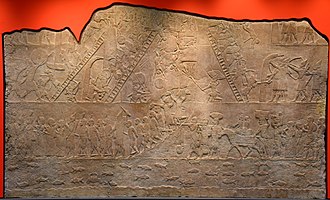
Upon the Assyrian king's departure, however, Taharqa intrigued in the affairs of Lower Egypt, and fanned numerous revolts. Esarhaddon died en route to Egypt, and it was left to his son and heir Ashurbanipal to once again invade Egypt. Ashurbanipal defeated Taharqa in 667 BCE, who afterwards fled to Thebes. Ashurbanipal marched the Assyrian army as far south as Thebes, and sacked numerous revolting cities:
Rassam cylinder of Ashurbanipal"In my first campaign I marched against Magan, Meluhha, Taharqa (
Tar-qu-u), king of Egypt ( , Mu-ṣur) and Ethiopia ( Ku-u-si "Kush"), whom Esarhaddon, king of Assyria, the father who begot me, had defeated, and whose land he brought under his sway. This same Taharqa forgot the might of Ashur, Ishtar and the other great gods, my lords, and put his trust upon his own power. He turned against the kings and regents whom my own father had appointed in Egypt. He entered and took residence in Memphis, the city which my own father had conquered and incorporated into Assyrian territory...."
The rebellion was stopped and Ashurbanipal appointed as his vassal ruler in Egypt Necho I, who had been king of the city Sais, and Necho's son Psamtik I, who had been educated at the Assyrian capital of Nineveh during Esarhaddon's reign.[35] After his victory, Ashurbanipal left Egypt.
Death
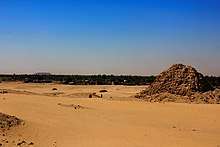
Taharqa died in city of Thebes[36] in 664 BC. He was followed by his appointed successor Tantamani, a son of Shabaka, himself succeeded by a son of Taharqa, Atlanersa. Taharqa was buried at Nuri, in North Sudan.[37] Egypt was still seen as vulnerable and Tantamani invaded Egypt in hopes of restoring his family to the throne. This led to a renewed conflict with Ashurbanipal and the sack of the city by the Assyrians in 663 BCE.
Biblical references

Taharqa has been suggested to be the Biblical "Tirhakah", king of Ethiopia (Kush), who waged war against Sennacherib during the reign of King Hezekiah of Judah (2 Kings 19:9; Isaiah 37:9).[38]
The events in the biblical account are believed to have taken place in 701 BC, whereas Taharqa came to the throne some ten years later. If the title of king in the biblical text refers to his future royal title, he still may have been too young to be a military commander.[39]
Herodotus, the Greek historian who wrote his Histories c. 450 BC, speaks of a divinely-appointed disaster destroying an army of Sennacherib, which was defeated by Sethos (probably Shebitku) after praying to the gods. The gods sent "a multitude of field-mice, which devoured all the quivers and bowstrings of the enemy, and ate the thongs by which they managed their shields."[40] This is commemorated in "a stone statue of Sethos, with a mouse in his hand, and an inscription to this effect 'Look on me, and learn to reverence the gods'."
According to Francis Llewellyn Griffith, an attractive hypothesis is to identify the pharaoh as Taharqa before his succession, and Sethos as his Memphitic priestly title, "supposing that he was then governor of Lower Egypt and high-priest of Ptah, and that in his office of governor he prepared to move on the defensive against a threatened attack by Sennacherib. While Taharqa was still in the neighbourhood of Pelusium, some unexpected disaster may have befallen the Assyrian host on the borders of Palestine and arrested their march on Egypt."[41]
The two snakes in the crown of pharaoh Taharqa show that he was the king of both the lands of Egypt and Nubia.
Depictions
Taharqa, under the name "Tearco the Aethiopian", was described by the Ancient Greek historian Strabo as having "Advanced as far as Europe",[42] and (citing Megasthenes), even as far as the Pillars of Hercules in Spain:[43]
"However, Sesostris, the Aegyptian, he adds, and Tearco the Aethiopian advanced as far as Europe; and Nabocodrosor, who enjoyed greater repute among the Chaldaeans than Heracles, led an army even as far as the Pillars. Thus far, he says, also Tearco went"
In biblical depictions, he is the saviour of the Hebrew people, as they are being besieged by Sennacherib (Isaiah 37:8-9, & 2 Kings 19:8-9), in a sense saving from Assyrian annihilation Judaism and its future offshots, Christianity and Islam.[45]
Actor Will Smith was developing a film entitled The Last Pharaoh, which he planned to produce and star as Taharqa. Carl Franklin contributed to the script.[46] Randall Wallace was hired to rewrite in September 2008.[47]
Monuments of Taharqua
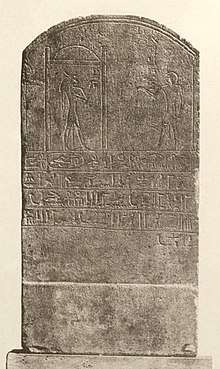
Taharqa has left monuments throughout Egypt and Nubia. In Memphis he rebuilt or restored the Temple of Amon.[49].
Taharqa in Karnak
Taharqa is known for various monuments in Karnak.
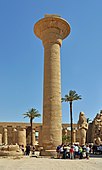 Taharqa column
Taharqa column- Kiosk of Taharqa in Kanark
 Chapel of Taharqa and Shepenwepet in Karnak
Chapel of Taharqa and Shepenwepet in Karnak
Shrine of Taharqa in Kawa
A small temple of Tahaqa was once located at Kawa in Nubia (modern Sudan). It is located today in the Ashmolean Museum.[50]
 The Shrine of Taharqa, Ashmolean Museum
The Shrine of Taharqa, Ashmolean Museum Shrine and Sphinx of Taharqa. Taharqa appears between the legs of the Ram-Spinx
Shrine and Sphinx of Taharqa. Taharqa appears between the legs of the Ram-Spinx The Ram-Spinx and Taharqa
The Ram-Spinx and Taharqa Relief of Taharqa on the shrine
Relief of Taharqa on the shrine Taharqa cartouche on the Shrine
Taharqa cartouche on the Shrine
._He_makes_an_offering_to_the_ram-headed_god_Amun-Re._Kawa_shrine.jpg)

Taharqua in Jebel Barak
Taharqa is depicted in various reliefs in Jebel Barkal, particularly in the Temple of Mut.
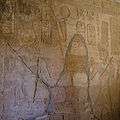 Taharqa before the god Amun in Gebel Barkal (Sudan), in Temple of Mut, Jebel Barkal
Taharqa before the god Amun in Gebel Barkal (Sudan), in Temple of Mut, Jebel Barkal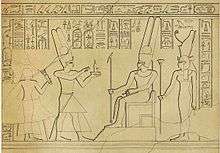 Taharqa followed by his mother Queen Abar. Gebel Barkal - room C.
Taharqa followed by his mother Queen Abar. Gebel Barkal - room C.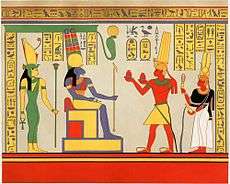 Taharqa with Queen Takahatamun at Gebel Barkal.
Taharqa with Queen Takahatamun at Gebel Barkal.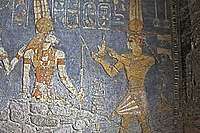 Lion-headed God Appademak with Pharaoh Taharqa (right) in the Jebel Barkal Temple of Mut.
Lion-headed God Appademak with Pharaoh Taharqa (right) in the Jebel Barkal Temple of Mut.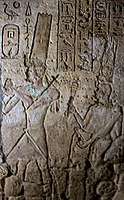
Museum artifacts
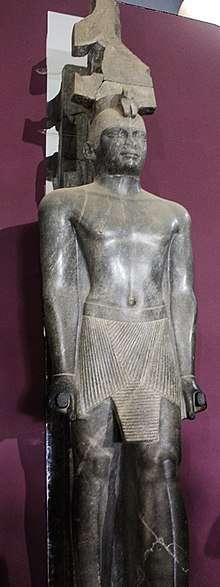 Statue of Pharaoh Taharqa in the National Museum of Sudan
Statue of Pharaoh Taharqa in the National Museum of Sudan.jpg) Taharqa, ca. 690-64 BCE, Ny Carlsberg Glyptotek, Copenhagen.
Taharqa, ca. 690-64 BCE, Ny Carlsberg Glyptotek, Copenhagen. Taharqa under a sphinx, British Museum
Taharqa under a sphinx, British Museum Taharqa appears as the tallest statue in the back (2.7 meters), Kerma Museum.[54]
Taharqa appears as the tallest statue in the back (2.7 meters), Kerma Museum.[54] Granite sphinx of Taharqa from Kawa in Sudan
Granite sphinx of Taharqa from Kawa in Sudan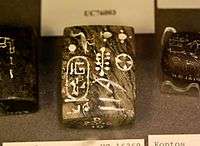 Serpentine weight of 10 daric. Inscribed for Taharqa in the midst of Sais. 25th Dynasty. From Egypt, probably from Nesaft. The Petrie Museum of Egyptian Archaeology, London
Serpentine weight of 10 daric. Inscribed for Taharqa in the midst of Sais. 25th Dynasty. From Egypt, probably from Nesaft. The Petrie Museum of Egyptian Archaeology, London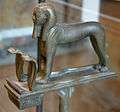 Taharqa as a sphinx
Taharqa as a sphinx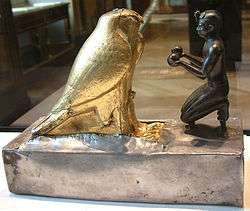 Taharqa offering wine jars to Falcon-god Hemen
Taharqa offering wine jars to Falcon-god Hemen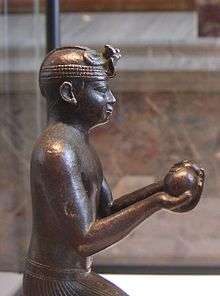 Taharqa close-up
Taharqa close-up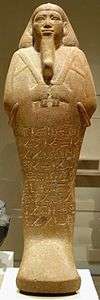 Shabti of King Taharqa
Shabti of King Taharqa
See also
| Wikimedia Commons has media related to Taharqa. |
References
- Elshazly, Hesham. "Kerma and the royal cache". Cite journal requires
|journal=(help) - Elshazly, Hesham. "Kerma and the royal cache". Cite journal requires
|journal=(help) - Clayton, Peter A. Chronicle of the Pharaohs: The Reign-by-Reign Record of the Rulers and Dynasties of Ancient Egypt. Thames & Hudson. p.190. 2006. ISBN 0-500-28628-0
- Aidan Dodson & Dyan Hilton, The Complete Royal Families of Ancient Egypt, (London: Thames & Hudson, 2004) ISBN 0-500-05128-3, pp.234-6
- Burrell, Kevin (2020). Cushites in the Hebrew Bible: Negotiating Ethnic Identity in the Past and Present. BRILL. p. 79. ISBN 978-90-04-41876-9.
- "Pharaoh Taharqa ruled from 690 to 664 BCE and in all likelihood was the last black pharaoh to rule over all of Egypt" in Dijk, Lutz van (2006). A History of Africa. Tafelberg. p. 53. ISBN 978-0-624-04257-0.
- Toby Wilkinson, The Thames and Hudson Dictionary of Ancient Egypt, Thames & Hudson, 2005. p.237
- Kitchen 1996, p. 380-391.
- Kitchen 1996, p. 161.
- Kitchen 1996, p. 167.
- Payraudeau 2014, p. 115-127.
- Payraudeau 2014, p. 122-3.
- [52 – JWIS III 132-135; FHN I, number 21, 135-144.]
- [53 – JWIS III 135-138; FHN I, number 22, 145-158.]
- Broekman, G.P.F. (2015). The order of succession between Shabaka and Shabataka. A different view on the chronology of the Twenty-fifth Dynasty. GM 245. p. 29.
- Török, László. The Kingdom of Kush: Handbook of the Napatan-Meroitic Civilization. Leiden: Brill, 1997. Google Scholar. Web. 20 Oct. 2011.
- Diop, Cheikh Anta (1974). The African Origin of Civilization. Chicago, Illinois: Lawrence Hill Books. pp. 219–221. ISBN 1-55652-072-7.
- Diop, Cheikh Anta (1974). The African Origin of Civilization. Chicago, Illinois: Lawrence Hill Books. pp. 219–221. ISBN 1-55652-072-7.
- Bonnet, Charles (2006). The Nubian Pharaohs. New York: The American University in Cairo Press. pp. 142–154. ISBN 978-977-416-010-3.
- Mokhtar, G. (1990). General History of Africa. California, USA: University of California Press. pp. 161–163. ISBN 0-520-06697-9.
- Emberling, Geoff (2011). Nubia: Ancient Kingdoms of Africa. New York: Institute for the Study of the Ancient World. pp. 9–11. ISBN 978-0-615-48102-9.
- Silverman, David (1997). Ancient Egypt. New York: Oxford University Press. pp. 36–37. ISBN 0-19-521270-3.
- Mokhtar, G. (1990). General History of Africa. California, USA: University of California Press. pp. 161–163. ISBN 0-520-06697-9.
- Emberling, Geoff (2011). Nubia: Ancient Kingdoms of Africa. New York: Institute for the Study of the Ancient World. pp. 9–11.
- Silverman, David (1997). Ancient Egypt. New York: Oxford University Press. pp. 36–37. ISBN 0-19-521270-3.
- Ephʿal 2005, p. 99.
- Mark 2014.
- Radner 2003, p. 171.
- Radner 2003, p. 171–172.
- Grayson 1970, p. 126.
- Radner 2012, p. 471.
- Luckenbill 1927, p. 227.
- "Wall panel; relief British Museum". The British Museum.
- Pritchard, James B. (2016). Ancient Near Eastern Texts Relating to the Old Testament with Supplement. Princeton University Press. p. 294. ISBN 978-1-4008-8276-2.
- Mark 2009.
- Historical Prism inscription of Ashurbanipal I by Arthur Carl Piepkorn page 36. Published by University of Chicago Press
- Why did Taharqa build his tomb at Nuri? Conference of Nubian Studies
- http://www.jewishencyclopedia.com/articles/14403-tirhakah
- Stiebing Jr, William H. (2016). Ancient Near Eastern History and Culture. Routledge. p. 279. ISBN 9781315511160. Retrieved 23 December 2018.
- Herodotus (2003). The HIstories. London, England: Penguin Books. pp. 153. ISBN 978-0-14-044908-2.
- F.L. Griffith, Stories of the High Priests of Memphis: The Sethon of Herodotus and the Demotic Tales of Khamuas (1900), p. 11
- Strabo (2006). Geography. Cambridge, Massachusetts: Harvard University Press. p. 7. ISBN 0-674-99266-0.
- Snowden, Before Color Prejudice: The Ancient View of Blacks. Cambridge: Harvard University Press, 1983, p.52
- "LacusCurtius Strabo Geography Book XV Chapter 1 (§§ 1-25)". penelope.uchicago.edu.
- Jr, Donald E. Grant (2019). Black Men, Intergenerational Colonialism, and Behavioral Health: A Noose Across Nations. Springer Nature. ISBN 978-3-030-21114-1.
- Jim Slotek, Kevin Williamson (2008-03-23). "Will Smith set to conquer Egypt?". Jam Showbiz. Archived from the original on 2012-07-09. Retrieved 2008-03-23.
- Michael Fleming (2008-09-08). "Will Smith puts on 'Pharaoh' hat". Variety. Retrieved 2008-09-08.
- "L'An 6 de Taharqa" (PDF). Cite journal requires
|journal=(help) - Cf. D. Meeks, Hommage à Serge Sauneron
, 1979, Une fondation Memphite de Taharqa (Stèle du Caire JE 36861), p. 221-259. - "Taharqa Shrine". Ashmolean Museum.
- Museum notice
- Museum notice
- Museum notice
- Elshazly, Hesham. "Kerma and the royal cache". Cite journal requires
|journal=(help)
Sources
- Mark, Joshua J. (2009). "Ashurbanipal". Ancient History Encyclopedia. Retrieved 28 November 2019.
- Ephʿal, Israel (2005). "Esarhaddon, Egypt, and Shubria: Politics and Propaganda". Journal of Cuneiform Studies. University of Chicago Press. 57 (1): 99–111.
- Mark, Joshua J. (2014). "Esarhaddon". Ancient History Encyclopedia. Retrieved 23 November 2019.
- Radner, Karen (2003). "The Trials of Esarhaddon: The Conspiracy of 670 BC". ISIMU: Revista sobre Oriente Próximo y Egipto en la antigüedad. Universidad Autónoma de Madrid. 6: 165–183.
- Radner, Karen (2012). "After Eltekeh: Royal Hostages from Egypt at the Assyrian Court". Stories of long ago. Festschrift für Michael D. Roaf. Ugarit-Verlag: 471–479.
- Radner, Karen (2015). Ancient Assyria: A Very Short Introduction. Oxford University Press. ISBN 978-0-19-871590-0.
- Grayson, A. K. (1970). "Assyria: Sennacherib and Esarhaddon (704–669 BC)". The Cambridge Ancient History Volume 3 Part 2: The Assyrian and Babylonian Empires and Other States of the Near East, from the Eighth to the Sixth Centuries BC. Cambridge University Press. ISBN 978-3111033587.
- Luckenbill, Daniel David (1927). Ancient Records of Assyria and Babylonia Volume 2: Historical Records of Assyria From Sargon to the End. University of Chicago Press.
Further reading
- Kitchen, Kenneth Anderson (1996). The Third Intermediate Period in Egypt (1100–650 BC) (3rd ed.). Aris & Phillips Ltd. p. 608. ISBN 9780856682988.CS1 maint: ref=harv (link)
- Payraudeau, Frédéric (2014). Retour sur la succession Shabaqo-Shabataqo (in French). pp. 115–127.CS1 maint: ref=harv (link)
- Morkot, Robert (2000). The Black Pharaohs: Egypt's Nubian Rulers. The Rubicon Press. p. 342. ISBN 0-948695-23-4.

